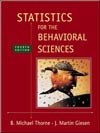 |  Statistics for the Behavioral Sciences, 4/e Michael Thorne,
Mississippi State University -- Mississippi State
Martin Giesen,
Mississippi State University -- Mississippi State
Graphing Data
Learning Objectives
After completing this chapter, you should- understand the following graphing conventions: the three-quarters rule and X-axis values should begin with 0 and reflect reasonable deviations in the data.
- be able to construct the following types of graphs: the frequency polygon, the cumulative frequency curve, the histogram, the bar graph, the stem-and-leaf plot, and the line graph.
- appreciate the differences between the normal curve and skewed curves.
|
|



 2003 McGraw-Hill Higher Education
2003 McGraw-Hill Higher Education